
McLaren F1 Reborn… Rowan Atkinson’s crashed supercar resurrected. “Now I want to do 100,000 miles in it” 240mph daily driver… The story of one (rather famous) man’s 15-year passion for the world’s most spectacular supercar… The ultimate rebuild Atkinson’s McLaren F1 brought back to life… “It depresses me when great cars are hidden away. It’s a crime not to use it” Meet the world’s most dedicated F1 owner, says Simon Taylor as he follows the rebuild of Rowan Atkinson’s beloved McLaren. Photography by Tony Baker.
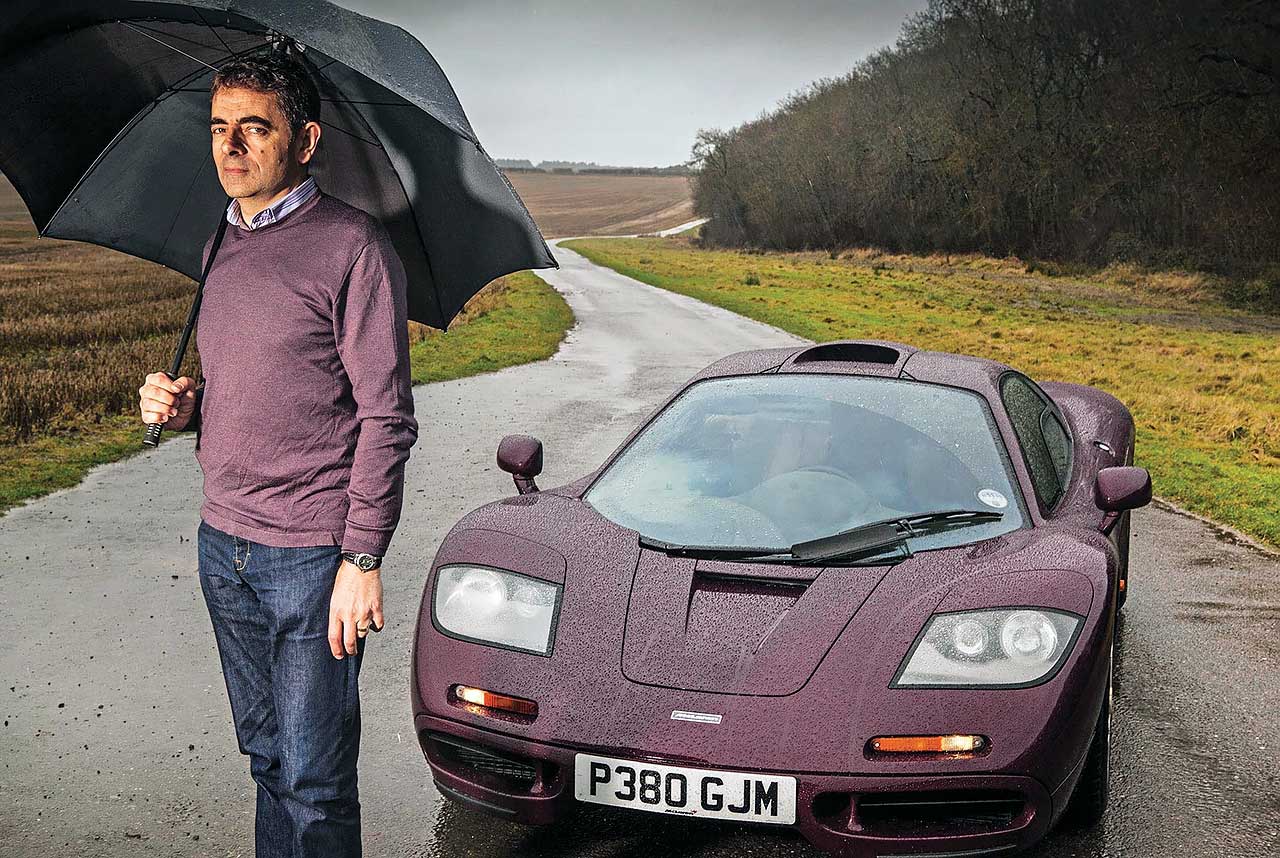
We all know about modern ‘ supercars: those Veyrons and Aventadors, those Huayras and Ageras. They park outside trendy night clubs, gather dust in rock stars’ lock-ups, decorate small boys’ bedroom walls.
And then, on a different planet altogether, there’s the McLaren F1.
If we’re asked to choose the six greatest four-wheeled devices of all time, we’ll start arguing over maybe two dozen different contenders. But for most of us, in there with the Type 57SC Bugatti, the Jaguar XKSS, the Ferrari 250GT SWB or the 8C Alfa-Romeo, will be Gordon Murray’s 1990s vision of the ultimate road car.
It is small, neat, deliberately almost undramatic: no ugly aerofoils, no flamboyant aerodynamic add-ons. And no traction control, no power steering, not even a brake servo. Just a normally aspirated 627bhp V12 in a central-drive, carbonfibre three-seater with a weight of 1100kg (2425lb) and a top speed of more than 230mph. Murray’s avowed aim was, above all, to build a pure driver’s car. Our colleagues on Autocar, having carried out the only fully figured road test of the F1 in 1994, called it ‘the finest driving machine yet built for the road’, and judged its very existence to be ‘one of the great events in the history of the car’.
A total build of 300 was planned, at a breath-taking sticker price of £634,500. But it’s no secret that McLaren lost money on every one. Each car took 3500 hours to make, and in the end only 64 examples of the pure F1, as Murray had intended it, ever left Woking. In addition there were 28 race cars, eight LMs and long-tails, plus six prototypes. Small wonder that over the past two decades those 64 have rocketed in value: the last one to change hands cost its new owner £3.4million. Most have had more than one keeper in the 20-odd years since they were built; some have had several. But if cars become more valuable, they get used less. So inevitably, given their extraordinary worth today, most McLaren F1s have covered very few miles.

Not so the F1 owned, from new, by Rowan Atkinson. The star of Blackadder and Mr Bean, currently on the West End stage heading the cast of Quartermaine’s Terms, happens to be a lifelong car enthusiast, and a discerning and extremely well-informed one. Over the years he has owned a variety of desirable machines. He has raced a few of them, too, from his 1950s MkVII Jaguar at the Goodwood Revival to his ’80s Aston Martin V8 Zagato – probably the only example that has been campaigned on the circuits. But in recent years he has decided that only one car is needed to satisfy his love of exceptional motoring, and he has sold the rest of his collection. Apart from a 1960s Ford Falcon for historic racing when his schedule allows, plus workaday examples of Audi, Land-Rover and the ubiquitous VW Golf, his sole automotive indulgence is his McLaren F1. He drives it all year round, in all weathers: on long cross-country blasts, on motorways, on rural byways, even in urban traffic, simply as a joyous means to get around. That’s why the odometer shows the quite exceptional total, for such a car, of 38,000 miles.
Responsible McLaren ownership involves substantial care and expense. If you live too far from the factory, or from one of the five McLaren-approved specialists around the world, a team of technicians will fly out to you when a service is due. That’s every 5000 miles or every year, whichever comes first, and can result in a bill for anything between £20,000 and £40,000. Driveshafts, for example, have a life of 20,000 miles. The triple-plate carbon clutch, capable of transmitting all that power and torque to the transverse gearbox and yet with a wonder-fully light action, doesn’t live long in give-and-take daily motoring, and Atkinson admits to being on his eighth. Even the fuel tank, a very expensive item, has a prescribed life.
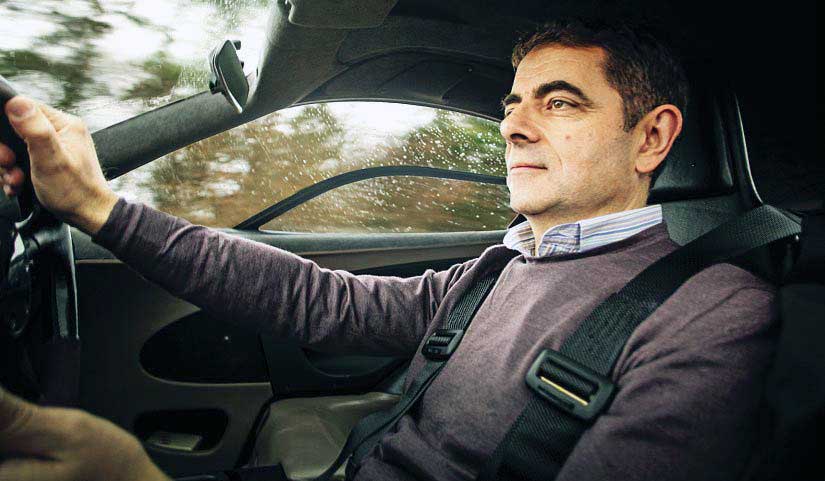
He describes the experience of driving the car as “almost vintage. It’s 20-year-old technology, remember, and it’s the last of a breed of very high-performance cars with a tremendous power-to-weight ratio and no electronic nannies to look after the driver. With virtually no flywheel effect the throttle response is instantaneous, and there is massive torque throughout the rev range. So it’s challenging, and it’s always going to require respect at any speed. It’s not dangerously tricky, but it does need care. It does help that the accelerator linkage is nonlinear, so a small throttle opening requires proportionally more pedal movement, which helps to make it drivable in traffic.”
Atkinson rejoices in the F1’s restrained appearance, which in his car’s case is enhanced by its non-celebrity seven-digit P-reg numberplates and its colour, a sober deep maroon that he describes, with a grin of self-parody, as being “like a pool of spilt claret”. His ownership proves that Gordon Murray’s determination to produce a supercar that was really practical for everyday use has been achieved. He has used it for long road trips, commuting around London, going to race meetings, even for a holiday in the West Country with his two children. The F1’s luggage lockers, if the bespoke suitcases are correctly packed, are said to hold more than a 5 Series BMW saloon. When shooting the film Mr Bean’s Holiday he drove the McLaren to the Cote d’Azur, and particularly enjoyed the N85 Route Napoleon down towards Cannes.

Then, after 14 years of McLaren miles on all sorts of roads, in all sorts of weather, one Friday afternoon in August 2011 he had a very nasty accident. Accelerating hard in fourth, he hit a sudden slippery patch, and the car got away from him incredibly quickly and spun. The right rear hit a tree, and it was a very big impact: the engine and drivetrain ended up 20 yards away. Rowan himself suffered a severely broken shoulder blade. But at once his prime concern was how to return the car to exactly how it should be.
First it was taken to McLaren Special Opera-tions and stripped to its component parts, so that the insurance company could be told what it would cost to restore the car to MSO’s – and Atkinson’s – standards of perfection. MSO is an offshoot of McLaren Automotive, which currently builds the MP4/12C road car. Much of the work done by its 39-strong team, in separate premises outside the McLaren Technology Centre campus, is on current 12Cs and Mercedes-Benz SLR McLarens, whether it be organising a different-colour upholstery stitch specified by a fussy owner or executing major bespoke engine, chassis and body alterations. Last year’s 12C XI concept car was a new 12C entirely disassembled and rebuilt by MSO.
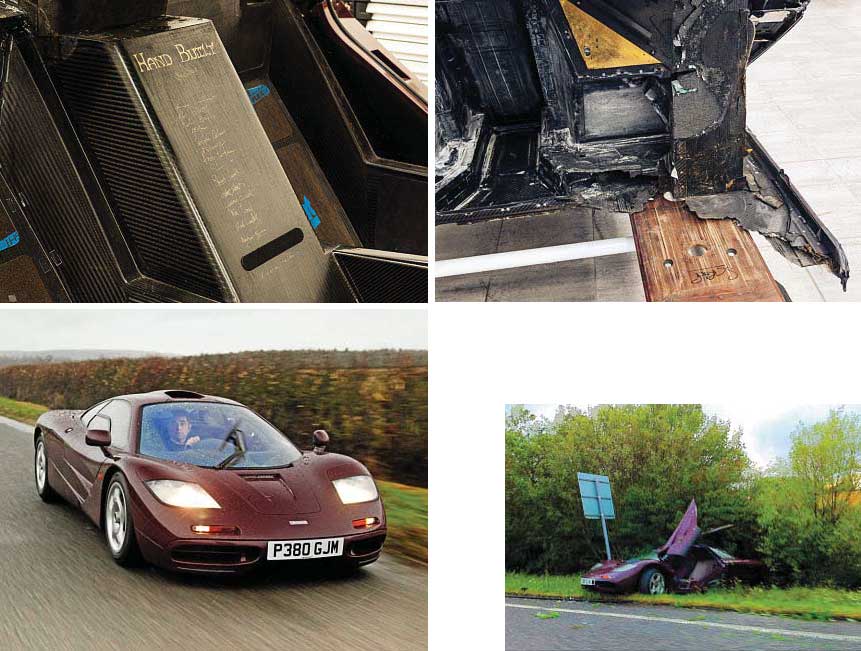
That estimate took four weeks to produce. Then the insurance company spent long months deliberating over it – because the figure in the bottom right-hand corner was an eye-watering £910,000. That’s nearly half as much again as the car cost new. But with today’s values currently running at well over £3million, it was a job that had to be done right, by the right people. It was the end of March 2012 before the go-ahead finally came through, and the work could start.
‘THE F1 IS A CLASSIC AND HAS BECOME PART OF MY LIFE: I HOPE TO DO 100,00 MILES IN IT’
Barry Lett, who was a key member of Gordon Murray’s original design team on the F1 20 years ago, became personally involved in the rebuild. The F1’s chassis monocoque consists of some 48 pieces of carbonfibre, bonded together with two-pack epoxy glue, and a multitude of further pieces of the same material complete the body assembly. To help put this complex modular jigsaw puzzle back together the original F1 jig, decommissioned in 1998, was brought out of storage. In the past there has been a worse- damaged F1, but that was rebuilt around a new tub – which, by some measures, in effect made it a new car. But Atkinson insisted that this should be an authentic repair that in every way continued the integrity of F1 061, just as he’d owned and enjoyed it since new. So it was vital to retain as much as possible of the original, to reconfigure rather than to replace. In the end an entire new floor was required, but most of the rest of the structure was reused. The engine cover and right-hand door had to be replaced; but the left-hand door, cracked and perforated where the mirror had been torn out, was repaired.
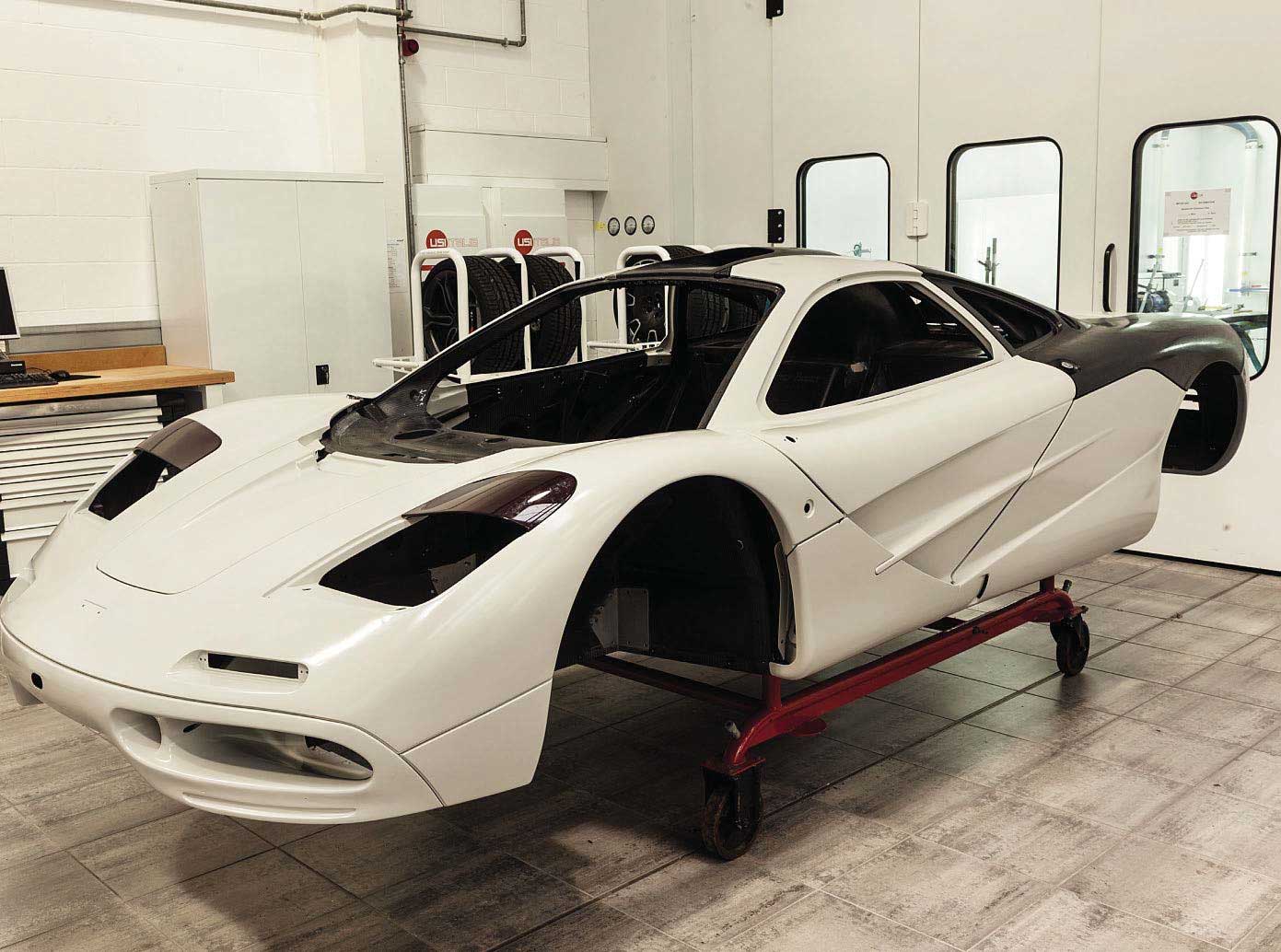
All of this expert work to restore the tub was carried out in Sussex by carbonfibre specialist GTR Composites at its premises in Fontwell. When the F1s were built new, the carbonfibre work was all done at the McLaren premises in Shalford, where Gordon Murray Design is now. But two of the technicians who assembled the original cars are now with GTR, and were able to play a major part in the rebuild. Lett made several visits to ensure that everything was exactly right, including a vital dry fit of the floor, seats and tunnel unit to the inner and outer ‘spider’ – the roof and ’screen surrounds – to ensure that all joints lined up to minute perfection before the glue process could begin.
‘HE DRIVES IT IN ALL WEATHERS, ALL YEAR ROUND, ASA JOYOUS MEANS TO GET AROUND’
The spider is the single most critical part of the whole assembly, because the glass and all the closures mount to it. All of the glass had to be replaced, including the windscreen, which uses fighter-jet technology: a plasma coating between the laminates has 50 volts passed through it so that it will never mist up.
The front casting of the engine, and the engine mounts, were badly damaged, as well as many of the ancillaries, so the whole unit had to go back to maker BMW in Munich. The gearbox had to be returned to its manufacturer, Ricardo, because the internal mountings were affected. Of course, all of the running gear, suspension and brakes had to be subjected to meticulous stress tests and crack detection, and this was done to Formula 1 standards in the McLaren Racing workshops.
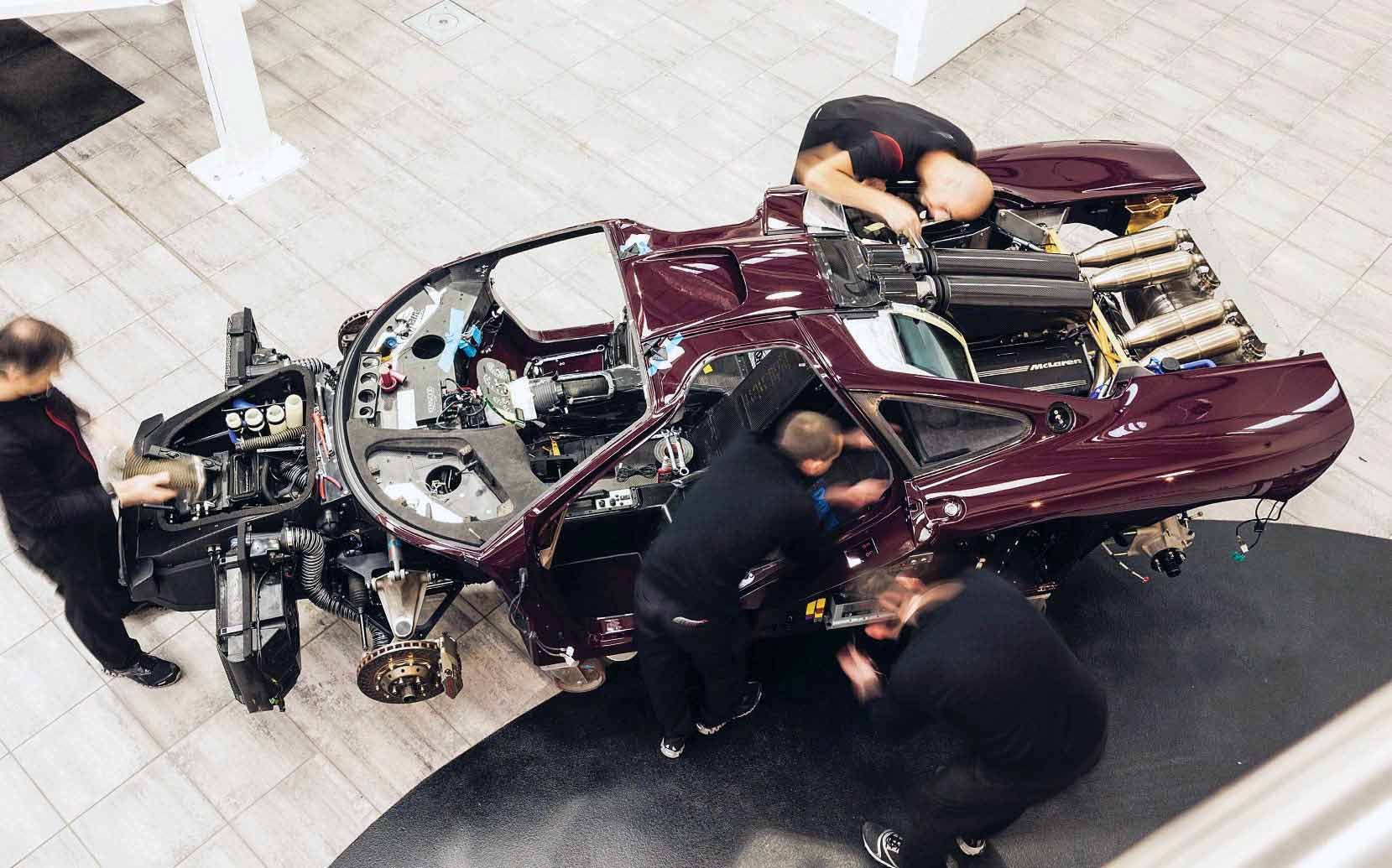
Finally, once all of the parts had been brought back together, the entire car had to be painstakingly reassembled, and painted in-house. Again, as much as possible of the original lives on. The steering wheel, for example, is unchanged, the patina of wear on the leather rim showing pleasing evidence of all those miles.
It was late November before 061 was running again. Peter Taylor, who has done more test and development mileage in F1s than anyone, came out of retirement to head up the lengthy shakedown procedure, starting with handling tests at MIRA. In early December came straight-line speed runs at a wet and patchily icy Bruntingthorpe. The insurance assessor, paying a visit to checkup on things, was persuaded to ride shotgun as Taylor touched 203mph. Further sessions at Longcross Test Track, close to the McLaren factory, checked for squeaks and rattles, and ensured that road noise was at no more than the approved level. Only then, following the production of a seven-page report, was the car signed off as finished.
Normally cars of this type, after workhas been done, are delivered back to their owners’ homes in a sober, anonymous truck. Rowan Atkinson doesn’t operate like that. At 9am on the day the FI was ready he turned up at McLaren’s palatial Technology Centre in Woking, where three MSO executives – operations controller Henry Winkworth-Smith, project manager of the entire rebuild, plus programme director Paul Mackenzie and head of operations James Banks – formally handed over the keys and the ‘rebuild book’, a massive file recording everything that had been done to the car over the previous 16 months. Then he drove off into the rain, round the rush-hour M25, onto the M4 and straight into central London. He parked the F1 near the theatre where he had a full day’s rehearsals; then he drove it 100 miles to his Northamptonshire home. Later he told me: “Getting back into it after 16 months was like putting on a familiar sweater.” Since then, no doubt, the 38,000 mileage on the odometer has increased further.

“I’m not a collector,” he says. “I don’t like the toy-cupboard syndrome that causes so many good cars to evaporate. It depresses me that they are hidden away like investment art, or gold ingots in a Swiss vault. The McLaren is just so usable, it’s a crime not to use it. No gritted teeth: you just get in and drive. The air-conditioning isn’t man enough for really hot climates – in the south of France the metal shank of the gearlever became too hot to touch – and the original headlights were poor, but a Xenon upgrade dealt with that. By modern standards the brakes aren’t great for the prodigious levels of performance. But it’s surprisingly quiet and comfortable. The driving seat, in its central position, is superb over long distances. And it remains rewarding even when driven slowly: as I have said elsewhere, to pootle is a pleasure.
“When I bought it in 1997 it all seemed pretty rash, because I was expecting it to depreciate. But of course it didn’t depreciate, far from it. Meanwhile, I’ve avoided buying new Aston Martins and Ferraris, which has saved me a fortune. I’ve never been interested in the F1’s monetary value, but it probably helped that it became a successful racing car, and won Le Mans at its first attempt. That absolutely wasn’t what Gordon wanted the car to be used for, but it did give it credibility in the way that the Jaguar D-type and the Ferrari 250GTO earned their status. In contrast the Bugatti Veyron, for example, has no race history, no charismatic designer: all it’s got is a famous badge.
“My F1 is only 15-years old, but it’s already a classic, in the tradition of the Type 59 Bugatti or the 2.9 Alfa. It has become part of my life. I hope to do 100,000 miles in it.”
Finally, it’s worth revisiting that Autocar road test. The acceleration figures were devastating: 0-60mph in 3.2 secs, 0-100mph in 6.3 seconds, 0-150mph in 12.8 secs. The standing quarter- mile occupied 11.1 secs. Obeying the 7500rpm limit, you don’t change into top until 180mph. With all of that performance testing, overall fuel consumption dropped to 15.2mpg; but the calculated touring figure was 23.4mpg, so the 90-litre tank gave a 460-mile range. The testers gave five stars to the F1’s handling, safety and build quality, and judged it to be: ‘A car that always inspires, never intimidates.’
Truly, the McLaren F1 is one of a tiny handful of the ultimately great cars of all time. We shall not see its like again.
F1: the making of an icon
In September 1988, when their flight home after the Italian Grand Prixwas delayed, McLaren’s first road car was mooted in an airport-lounge conversation between Gordon Murray, Ron Dennis, TAG boss Mans our Ojjeh and McLaren marketing man Creighton Brown. A key element, the one-plus- two central driving positioa dated back to an idea for a mid-engined GT sketched out by Murray as a young college student 20 years earlier.
By March 1989, the existence of a McLaren road-car company was made public, and Murray was gathering around him a dedicated little team to bring his vision to fruition, including Barry Lett from Lotus on the design side and Harold Dermott from Midas as production boss. Lotus Elan M100 designer Peter Stevens came on board as the car’s stylist, and the name F1 was chosen – although the story that this was to put it 39 steps ahead of the Ferrari F40 is probably apocryphal. A central ingredient in the whole project was carbon- composite construction for the chassis/body unit, to combine massive rigidity with light weight.
Murray’s insistence on vivid throttle response dictated a normally aspirated engine. After initial talks with Honda, it was BMW that provided the remarkable, purpose-built power unit, a 6.1-litre, four-cam, all-alloy V12 that doubled as a load- bearing chassis member. It produced a massive 627bhp at 7500rpm, and the immense torque started from very low revs: at just 1500rpm it was already pulling at 4001b ft. Surprisingly compact for its cubic capacity, this mighty engine drove through a Formula 1-style small-diameter carbon- carbon multi-plate clutch to a constant-mesh six- speed transverse gearbox, designed in the US by Pete Weismann and built in England by Ricardo.
Much wind-tunnel work produced a patented system of fan-assisted airstream management to generate downforce around and underneath the car without resorting to external aerofoils. The McLaren bristled with clever ideas in pursuit of Murray’s weight- and space-saving goals: for example, the silencer box required to tame the noise of more than 600 horses doubled as a rear impact-absorbing crush structure.
The F1 was formally launched in Monte-Carlo in May 1992. XP1, the first prototype, was written off in a fiery accident during hot-weather testing in Namibia. XP2was ultimately used for mandatory homologation crash-tests at MIRA. XP3, XP4 and XP5 followed, and intensive development testing continued. Jonathan Palmer was at the wheel on the Nardo bowl in Southern Italy when XP3 held a speed of 231mph for two miles. At the time, that was a full 18mph ahead of the then world’s fastest road car. Later, Andy Wallace achieved 240.1 mph in XP5 at the VW test track near Wolfsburg.
Two days before Christmas Day 1992, the first production car reached its fortunate owner. During 1993, two dozen road cars were delivered, with 15 in 1995, seven in 1996, 11 in 1997 and the last six in 1998 Meanwhile, during 1994 one or two well-heeled GT racers had begun to put pressure on McLaren to produce a racing version. From the start, Gordon Murray’s philosophy was to produce a no-compromises road car, and he had never envisaged that the F1 would be raced. But the GTR version of the F1 was developed, stripped of its internal comforts and lighter still with full rollcage, fire extinguisher system and aerodynamic changes for circuit work. It was ready to race at the start of the 1995 season, and duly won the first five rounds of the BPR Global Endurance Championship on the trot.
Then came the Le Mans 24 Hours. McLaren was favourite to take the GT1 class, but no one expected that it would win the race outright, beating all the sports-prototypes. In fact, McLarens finished first, third, fourth and fifth overall. The Harrods- sponsored GTR of Andy Wallace, Derek Bell and Justin Bell led until late in the race, when a gearbox glitch dropped it to third, handing a historic victory to the Lehto/Dalmas/Sekiya GTR.
Five GTR-style F1s were produced for the road, called F1 LMs. Later came a long-tailed GTR, and privateer McLarens continued to be raced through the ‘1997 season and on into ‘1998. In all, 28 GTRs were built, and there were three long-tailed road cars. On 25 May 1998, the last F1 was completed, destined for Mansour Ojjeh’s brother Aziz. The final total, including racers and prototypes, came to just 106.







